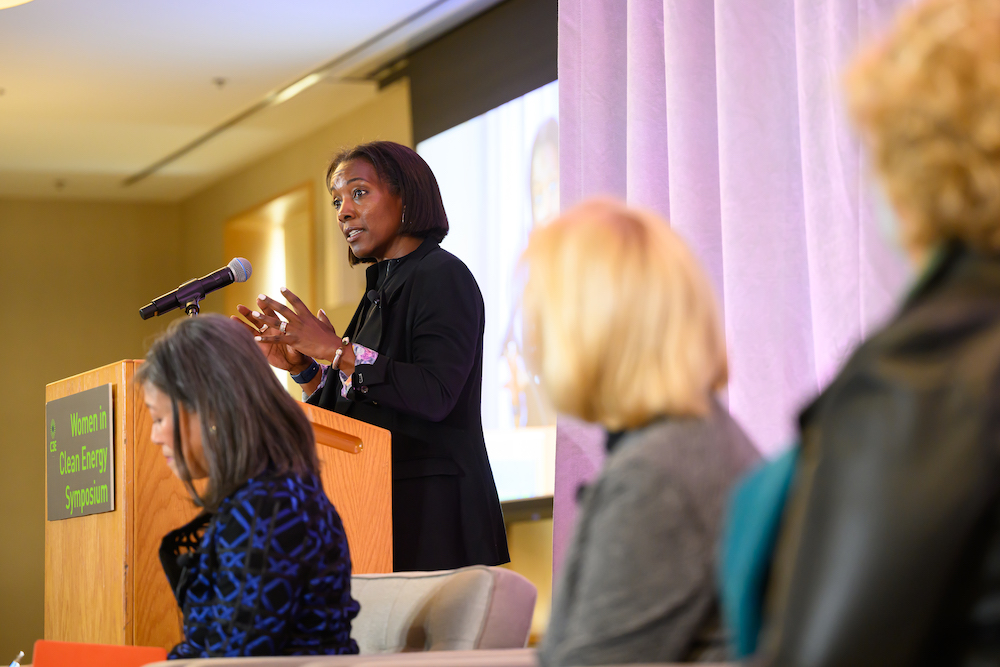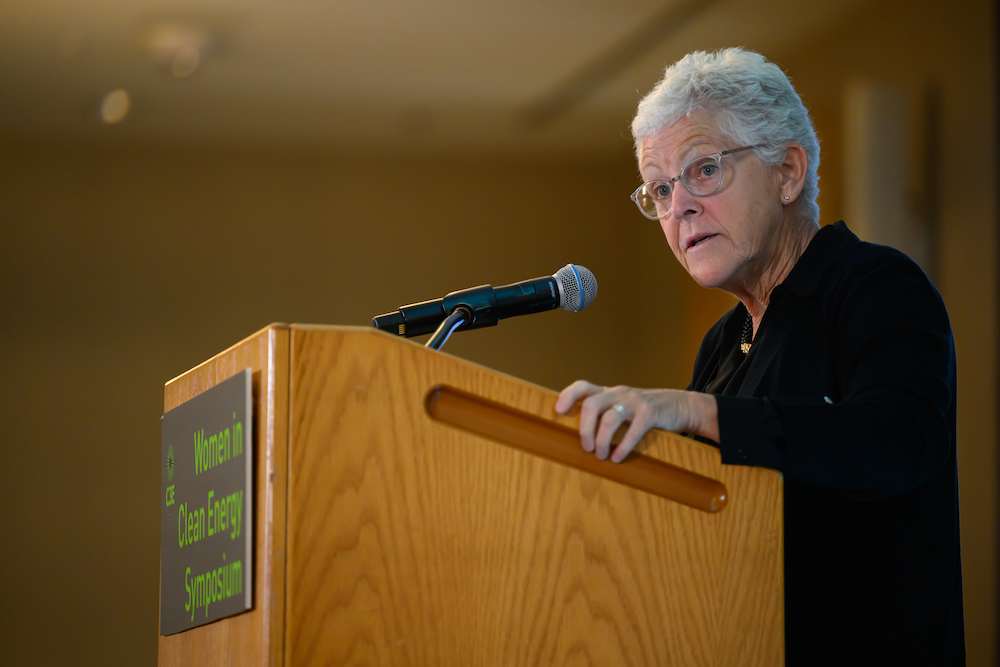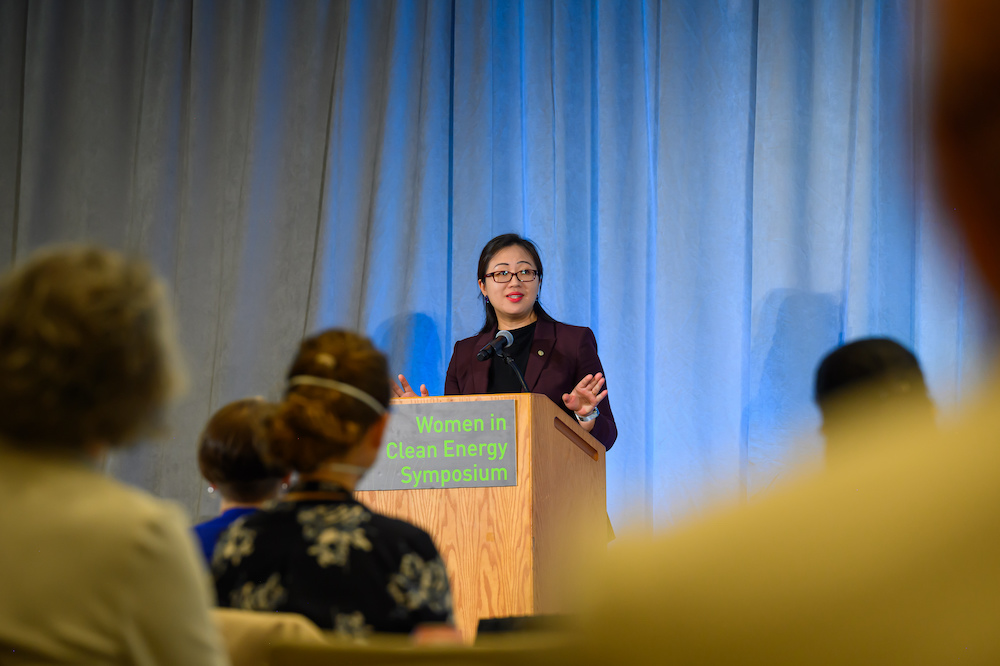
“There’s so much work ahead of us and so many obstacles in the way,” said Raisa Lee, director of project development with Clearway Energy Group, an independent clean power producer. But, added Lee, “It’s most important to focus on finding spaces and people so we can foster growth and support each other—the power of belonging!”
These sentiments captured the spirit of the 12th annual Women in Clean Energy Education and Empowerment (C3E) Symposium and Awards, held at MIT on September 27 and 28, 2023. The conference is part of the C3E Initiative, which aims to connect women in clean energy, recognize the accomplishments of leaders across different fields, and engage more women in the enterprise of decarbonization.
The conference topic, “Clearing hurdles to achieve net zero by 2050: Moving quickly, eliminating risks, and leaving no one behind,” spoke to the shared sense of urgency and commitment to community building among the several hundred participants attending in person and online.
As symposium speakers attested, the task of saving the world doesn’t seem as daunting when someone has your back.
Melinda Baglio, chief investment officer and general counsel of the renewable energy finance firm, CleanCapital, said “I have several groups of women in my life…and whenever I am doing something really difficult, I like to close my eyes for a minute and imagine their hands right on my shoulders and just giving me that support and pushing me forward to do the thing that I need to do.”
The C3E symposium was hosted by the MIT Energy Initiative (MITEI), which partners in the C3E Initiative with the U.S. Department of Energy (DOE), Stanford University’s Precourt Institute for Energy, and the Texas A&M Energy Institute.
Gender diversity and emissions
“Time is not on our side in the race to achieve net zero by 2050,” said Martha Broad, executive director of MITEI, in her opening remarks.”However, by increasing the gender diversity of the energy sector, we’re putting our best team forward to tackle this challenge.”
Closing a pronounced gender gap in corporate leadership and legislative bodies would also help, she said. Research has demonstrated that improving gender diversity in the energy sector leads to stronger climate governance and innovation. In addition, Broad noted, a recent study showed that increasing gender diversity in legislative bodies results in stronger climate policy and “hence lowers CO2 emissions.”
There was wide agreement that beating the clock on climate change means recruiting, training, and retaining a vast and diverse workforce. In talks and panels, symposium participants described their wide-ranging roles as leaders in this enterprise.
“This is a very exciting time to be working in clean energy, and an exciting time to be doubling down on the work that C3E does, because clean energy technologies are ready,” said Kathleen Hogan, principal undersecretary for infrastructure at DOE. In her keynote address, Hogan highlighted “the amazing, historic funding through the bipartisan infrastructure law and Inflation Reduction Act, where we are putting ultimately trillions of dollars into clean energy.” This presents a “tremendous opportunity to grow the clean energy workforce…to pull in the next generation of women to advance this field of work, and to figure out how to deliver the maximum impact.”

2023 C3E Lifetime Achievement Award winner Gina McCarthy rallied the symposium participants, encouraging them to “use each milestone as an opportunity to pat ourselves on the back and be more passionate than ever before” as “that is how change happens.” Credit: Gretchen Ertl
Gina McCarthy, who received the C3E lifetime achievement award, rallied symposium participants to remain hopeful and engaged. “It’s all about a world of new possibilities, new partnerships we can create together,” said the former White House national climate advisor and Environmental Protection Agency administrator. “Use each milestone as an opportunity to pat ourselves on the back and be more passionate than ever before—that is how change happens.”
“You belong”
Other speakers provided ample evidence of passion and persistence in their pursuit of clean energy goals.
C3E advocacy award winner and climate justice policy leader Jameka Hodnett works to ensure that historically underfunded Black communities benefit from decarbonization programs. Not all of her community contacts share her concerns about climate change or recognize the necessity of an energy transition. “This is difficult work, where I must be willing to stick my neck out and build relationships with others across differences,” she said.
Remote and often marginalized communities in the United States and around the world pose other kinds of challenges. Wahleah Johns, director of DOE’s Office of Indian Energy Policy and Programs, described the loss of jobs on tribal lands as fossil fuel companies shut down, and the problem of developing trust with local groups. She believes energy justice in these communities must draw “on indigenous, traditional knowledge of design, building, and planning” and demonstrate “value for future generations.”
Evangelina Galvan Shreeve, daughter of immigrant farmworkers, is tapping the talent of diverse communities to build the next generation’s clean energy workforce. The C3E education award winner, chief diversity officer, and director of STEM education at the Pacific Northwest National Laboratory, tells young people: “You are worthy of joining places you dream about, you are brilliant, and we need both to pursue the clean energy future. You belong.”
Reducing the carbon budget
In her keynote address, Sally M. Benson, Precourt Family Professor of Energy Science Engineering at Stanford University’s School of Earth, Energy, and Environmental Sciences, warned of the hazards of not acting quickly to reduce the global carbon budget. “It’s starting to cost us lots of money: In some years we are getting half a trillion dollars in damage,” she said. “We need all hands on deck, and to do that we need to align people’s views to give us the speed and scale to beat incredibly short timelines.”
Benson’s strategies include generating community- and city-scale, rather than individual-scale actions; streamlining the process for approving renewable energy projects; and advancing technological innovations based on “which would have the largest, transformational impact, the kind that could meet our 2050 [net-zero carbon emissions] goals.”
The symposium offered examples of innovations that could play out at the scale and speed that Benson recommends.
Elise Strobach SM ’17, PhD ’20 developed a nanoporous nanogel coating for windows that can cut energy losses—estimated at $40 billion a year—in half. Her spinout company, AeroShield Materials, Inc., aims to make windows light, thin, and affordable.
Claire Woo’s startup employer, Form Energy, has designed an iron-air battery that could bolster the electric grid as renewable sources such as sun and wind fuel more of the world’s energy needs. Stacked like so many blocks in giant arrays, the batteries provide 100-hour energy backup for multi-day power outages due to storms or other emergencies.

Jie Xiao, a Battelle Fellow and group leader of the Battery Materials and System Group at Pacific Northwest National Laboratory, accepts the 2023 C3E award for technology research and innovation. Credit: Gretchen Ertl
Grids and energy equity
Panelists discussed the requirements for resilient electric grids in the clean energy transition. Peggy Heeg, a corporate board member of the Electric Reliability Council of Texas (ERCOT), celebrated her state’s top-ranked status in solar and wind production but cautioned that “the shift is creating some real problems with our operations of the grid.” She believes that, currently, the only viable backup when heat or storms cause demand peaks is natural gas generation.
Caroline Choi, the senior vice president of corporate affairs at Edison International and Southern California Edison, described “unprecedented grid expansion” under way in California, as more solar and wind suppliers plug in. This will require “a significant acceleration in the pace of deployment of transmission systems,” said Julie Mulvaney Kemp, a research scientist at Lawrence Berkeley National Laboratory. Such expansion is complicated by fragmented regional planning, high costs, and local siting issues.
Not all power systems are super-sized. “I flew in small bush planes with my baby daughter in order to shadow Alaska microgrid operators,” said Piper Foster Wilder, founder and CEO of 60Hertz Energy and the C3E entrepreneurship award winner. Her software enables energy suppliers in even the most inaccessible places to monitor and protect utilities and infrastructure.
“Given the fundamental aspects of energy for life, the widely entrenched nature of the energy system, and the intersecting challenges with other priorities, everyone has a vital role to play,” said Kathleen Araújo, a professor of sustainable energy systems, innovation, and policy at Boise State University. In a panel devoted to energy justice, speakers hammered home the centrality of historically marginalized groups in achieving a global energy transition.
In the United States, communities must play a vital role in shaping their clean energy futures, whether former mining counties in Pennsylvania, Indian tribes whose lands have been exploited for fossil fuel production, or diesel-importing regions in Alaska, said Araújo. “Inclusive engagement, knowledge sharing, and other forms of collaboration can strengthen the legitimacy and [lead to] more enduring outcomes.”
Worldwide, 675 million people lack access to electricity, and 590 million of them live in sub-Saharan Africa, according to Rhonda Jordan Antoine, a senior energy specialist at The World Bank. The bank is committed to providing the populace of this vast region with reliable, renewable energy sources, customizing solutions to specific countries and communities. “Africa’s not just about connecting households to power but also supporting activities, agricultural productivity, and provision of essential services such as healthcare and education,” she said.
Whether confronting environmental injustice, supply chain gridlock, financing difficulties or communities resistant to addressing decarbonization, symposium participants candidly shared their challenges and frustrations. “I personally find this is really hard work,” Sally Benson acknowledged. “It took us 100 years or more to build the energy system that we have today and now we’re saying that we want to change it in the next 20 years.”
But the words of Gina McCarthy were invoked repeatedly over the two-day conference, lifting spirits in the room: “I am hugely optimistic,” she said. “The clean energy future isn’t just around, it isn’t just possible, it is already under way. And it is the opportunity of a lifetime.”
This article appears in the Winter 2024 issue of Energy Futures.